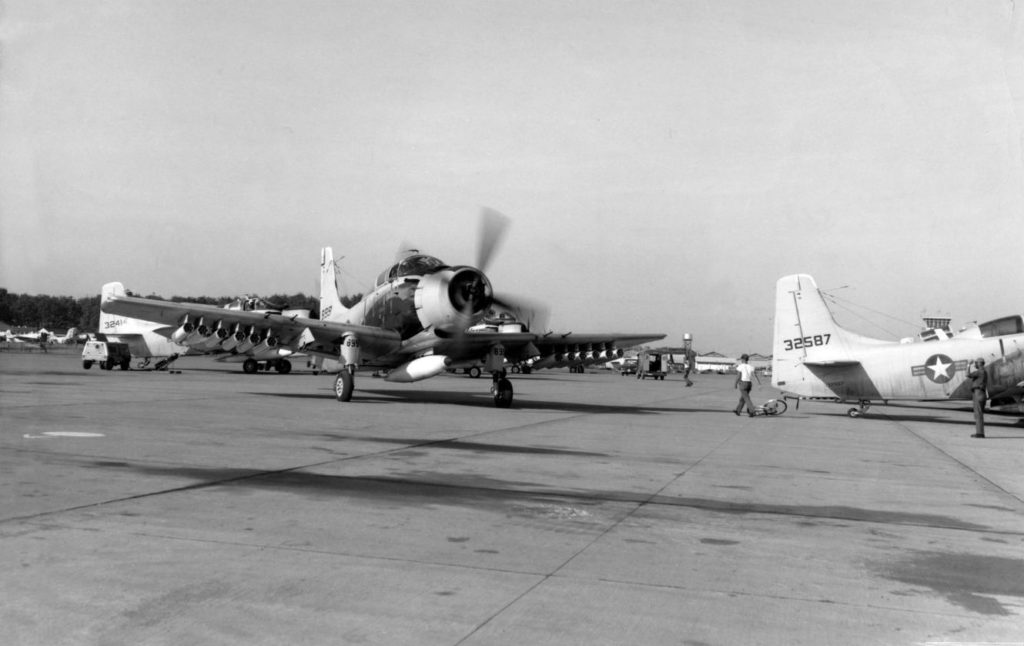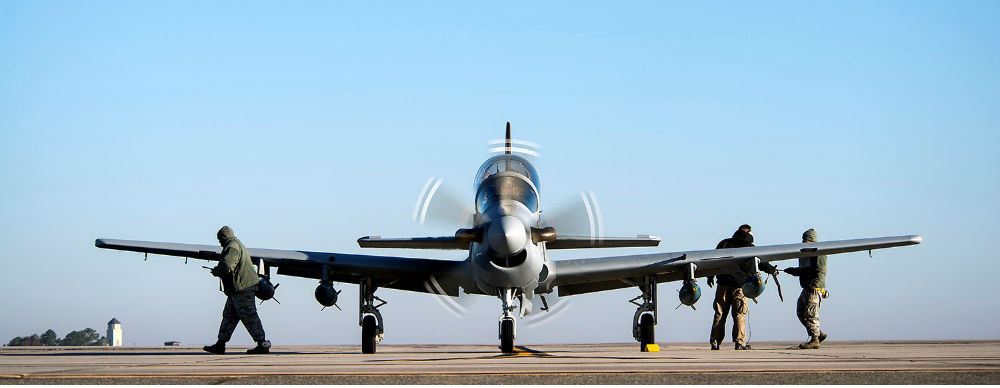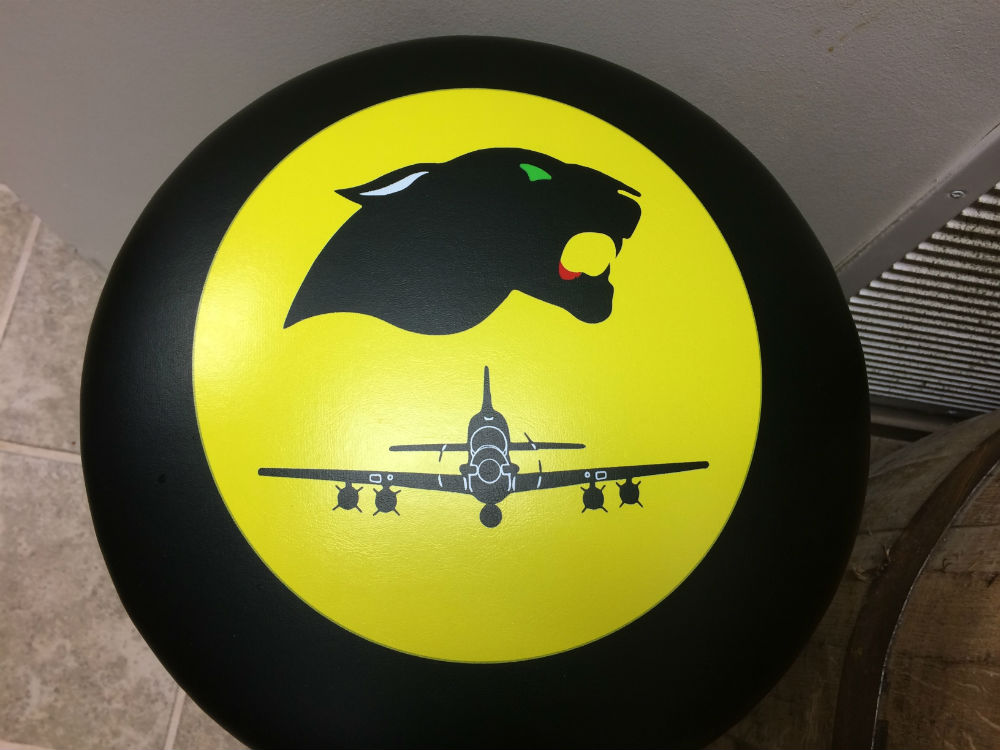Maladjusted, Part III: Not Your Father’s Skyraider

There are few things about insurgent warfare that favor the use of airpower, but one of them is that jungle rebels are not equipped with ack-ack or interception capability, so that air superiority is practically assured. On the other hand, the targets are fleeting, hard to locate, and are not subject to pattern bombing attacks. The aircraft require accurate weapons and good marksmanship, and they must be capable of loitering for long periods at low altitudes.
– “USAF Polishes Its New COIN,” Air Force Magazine, June 1962
In 1962, hidden away at the brand new Special Warfare Center at Eglin Air Force Base in Florida, the Air Force began a quiet evaluation of aircraft for counter-insurgency. They looked at the World War II-era B-26 Invader (later to become the A-26), converted T-28 trainers, and a Navy airplane – the Korean War’s AD-5 Skyraider. Rather than pick one, the Air Commandos picked all three, both for U.S. Air Force use (albeit covertly) and for the South Vietnamese Air Force. While the A-26 and T-28 became stalwarts for covert operations, the Skyraider was more mainstream. The Air Force accepted 150 Skyraiders, changed the designation to A-1E, and flew them up until the end of America’s involvement in Vietnam. The aircraft became a legend, renowned for toughness, a massive combat load, and far more endurance than the faster jets. The Skyraider experience directly influenced the A-X program, and thus the development of the A-10. Now, more than 40 years later, the Skyraider is influencing the Air Force once again as the spiritual forerunner to the OA-X, the proposed light attack bird. This is no accident.
In 1962 the Air Force began covertly assisting South Vietnam with T-28 Trojan and B-26B Invader under the Farm Gate program. At the time, the Air Force’s tactical aviation largely consisted of the “Century-series” aircraft (F-100 to F-106) that were designed either to defend North American against onrushing hordes of Soviet bombers, or deliver nuclear weapons in reply. A third of the force consisted of Korean-era relics and their derivatives, largely assigned to Air Defense Command. In Vietnam, where the U.S.-aligned regime of Ngô Đình Diệm was under increasing threat from Viet Cong insurgents, these aircraft were not useful. Farm Gate missions were flown with mixed American and Vietnamese crews to maintain the fiction that these were “advisory” missions. By 1964 the Farm Gate aircraft had American markings, and from then to 1972 it was the primary Air Force close air support (CAS) aircraft over Southeast Asia. Most A-1s were transferred to foreign customers after 1972, and the Air Force was done with the Skyraider by 1973. By then, the A-7D Corsair II was coming on line, and the first A-X prototypes had been built – designed with lessons learned from operating the A-1 in combat.
When Air Combat Command released the OA-X enabling concept in late 2008, the parentage of the concept was traceable directly to Vietnam and the A-1. The problems were similar then as now – the use of expensive fast jets was not the best way to tackle the airpower challenges associated with counter-insurgency warfare. A small, two-seat turboprop seemed a logical choice. Inexpensive, easy to maintain, matching significant firepower and with a low fuel demand, this class of aircraft already existed, and could be obtained at relatively low cost in a timeframe that the Air Force hasn’t experienced since the Air Force bought the F-100 practically off the showroom floor in 1952. Two generations after the Air Force concluded that a slow aircraft with good accuracy and long endurance was highly useful in low-intensity warfare, the concept is again in fashion.
Internal resistance was severe. Air Force leadership had justifiable concerns that adding aircraft without added funds was a recipe for fiscal catastrophe – it was already clear that by 2020, increasing costs would result in an aircraft procurement and sustainment bill beyond the Air Force’s means even under the most optimistic budget projections. The Air Force expected to leave Iraq in 2011, finally ending a severe strain on the existing force and allowing the Air Force to get out of the irregular warfare business. Other points of resistance were less well thought out – some considered the OA-X a threat to the F-35 program. The use of a turboprop for a modern attack aircraft inspired an emotional response to “old” technology. One general remarked that he wasn’t interested in developing a “bubba air force” while others remarked that light attack was fine – for foreigners. Even more recently, detractors have resorted to nonsensical statements that a nonexistent proliferation of advanced air defense systems would make non-stealthy aircraft useless.

It took time to overcome the institutional barriers embedded in the Air Force. This is an organization whose members have been trained to believe that the best aircraft for any task is the most expensive, and that being on the cutting edge of technology was the key to victory in any conflict, historical evidence be damned. Clearly, the turboprop light attack aircraft wasn’t a threat to the F-35 program. Iraq didn’t go away for long, and the expanding fight against violent extremists is likely to go on for a generation. Analysis of the fuel demands of fast jets made it clear that fuel resupply was a significant source of casualties. Careful examination of the infrared signature of turboprop aircraft revealed that they were much less vulnerable than their hotter jet-propelled cousins. And their small size makes them harder to hit with guns as well. But it may be that the Air Force’s purchase of A-29 Super Tucanos for the Afghan Air Force was the turning point, because it provided the Air Force with a cadre of combat-experienced instructor pilots who knew exactly how to use a light attack airplane and were training others to do it. This gave the Air Force a group of airpower professionals who could both advocate for light attack and demonstrate the capabilities – while adding hard, verifiable data to what previously had been an emotional argument.
The resistance is still there, both within the Air Force and without. However, recent discussions by Air Force Chief of Staff Gen. David Goldfein reveal a hint of adjustment. This year, the Air Force will experiment with light attack aircraft – following (but not closely) a successful operational test conducted by the Air Guard from 2010 to 2014. The experiment may or may not lead to a follow-on effort, but Sen. McCain, who chairs the Senate Armed Services Committee, has already indicated both interest in and support of an OA-X program if sequester can be ended. OA-X is not the only new aircraft concept to slip out from behind the curtain – the A-X2 and AT-X are both proposals for new attack aircraft. A long-overdue readjustment of the Air Force’s fighter / attack mix is not a done deal, but it is clearly on the table.
Col. Mike “Starbaby” Pietrucha was an instructor electronic warfare officer in the F-4G Wild Weasel and the F-15E Strike Eagle, amassing 156 combat missions over Iraq and the Former Republic of Yugoslavia and taking part in 2.5 SAM kills over 10 combat deployments. As an irregular warfare operations officer, Colonel Pietrucha has two additional combat deployments in the company of U.S. Army infantry, combat engineer, and military police units in Iraq and Afghanistan. The views expressed are those of the author and do not necessarily reflect the official policy or position of the Department of the Air Force or the U.S. government.
Image: National Museum of the U.S. Air Force


